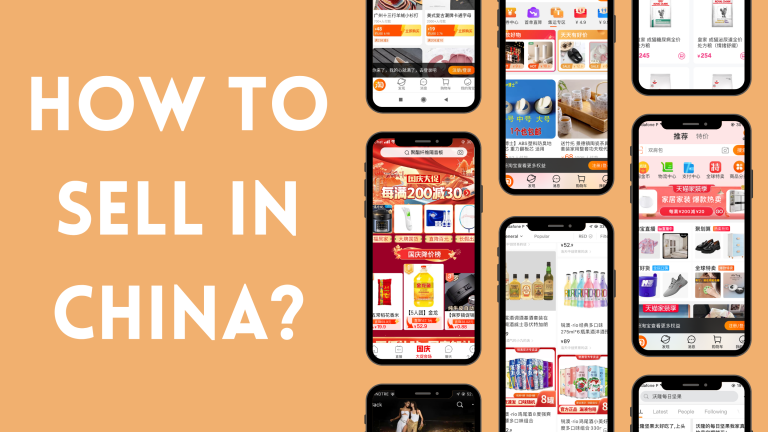Welcome to the Ultimate Guide to E-commerce in China! Did you know that China’s e-commerce market accounts for almost 50% of global transactions? It’s no wonder why many businesses are looking to penetrate this massive market. However, understanding and succeeding in the Chinese e-commerce landscape is not easy.
In this guide, we will provide you with comprehensive insights into the current status, trends, major players, platforms, and strategies for success in China’s e-commerce market. So buckle up and let’s dive into the lucrative world of Chinese online retail!
Need a cost effective TP (Tmall Partner) to sell in China?
We are an Official Tmall Partner e-commerce Agency. Our Services: E-Commerce, Search Engine Optimization, Advertising, Weibo, WeChat, WeChat Store & PR.
Key Takeaways
- China’s e-commerce market is the largest in the world and is projected to reach $1.556 trillion by 2024.
- Successful strategies for entering the Chinese e-commerce market include understanding trends like live streaming sales, platforms like Taobao and Tmall, JD.com, and Pinduoduo, and cross-border e-commerce channels such as Kaola, Tmall Global, and JD Worldwide.
- Alibaba Group stands tall as a giant in this domain owning two significant platforms: Taobao and Tmall while JD.com is China’s largest retailer with an expansive inventory ranging from electronics to apparel.
- Choosing the right platform depends on your specific needs. For example, brands that want to reach a massive audience with a wide range of products may use Taobao or Tmall while those who emphasize product quality may prefer selling on JD.com.

Current Status Of E-commerce In China
Currently, China stands as the largest e-commerce market globally with a staggering market size that’s twice as large as its closest competitor – the United States, projected to reach $1.556 trillion in 2024, an impressive 80% growth from $862 billion in 2019.
This growth in online shopping has been fueled by several factors such as rapid urbanization, increasing internet access, and mobile penetration rates, coupled with the rising disposable incomes of Chinese consumers.
The digital marketplace continues to evolve at breakneck speed; virtual storefronts are steadily replacing traditional brick-and-mortar retail stores while new technologies like social media shopping and cross-border e-commerce open up new opportunities for businesses looking to tap into this thriving market.
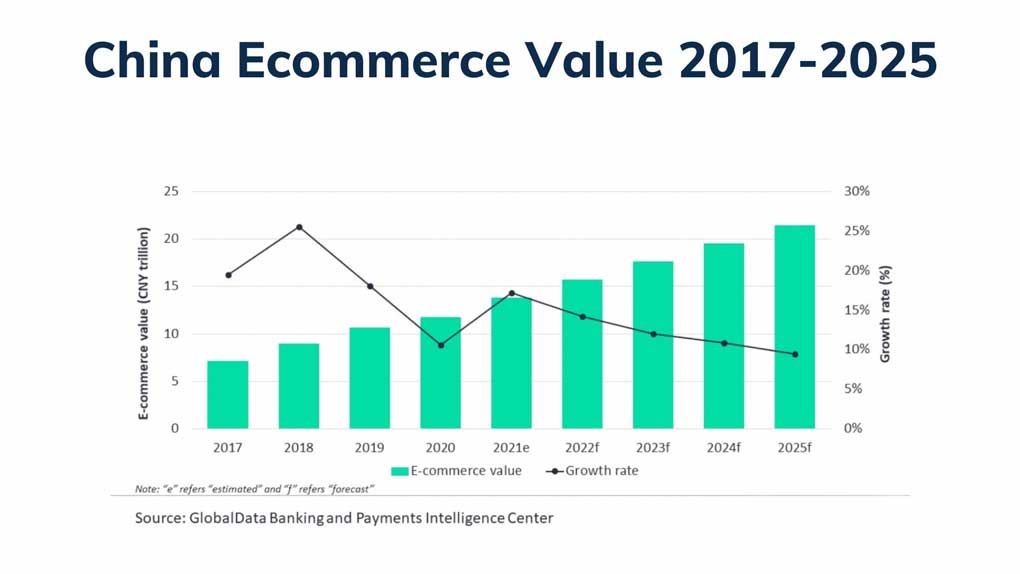
Trends In The Chinese E-commerce Market
As the world’s largest e-commerce market, China continually experiences rapid expansion and growth of trends that shape the industry globally. One significant trend in recent years is the shift toward “New Retail,” a concept pioneered by Alibaba.
Livestreaming has also taken center stage as an effective approach to real-time marketing and selling products directly to Chinese consumers. Through platforms like Taobao Live, brands can showcase their products via influencers or KOLs (Key Opinion Leaders) who engage with their massive followings, often resulting in impressive sales figures during live sessions.
Key Platforms For Selling Online In The Chinese eCommerce Market
Discover the essential platforms for online sales in China, from Taobao and Tmall to JD.com and Pinduoduo, and learn how each can benefit your business.
Taobao
Taobao, operated by Alibaba Group, is a highly influential e-commerce platform in China, based on C2C (consumer-to-consumer) model. It is often regarded as one of the best platforms for selling products, particularly for small and medium-sized businesses.

Taobao’s strength lies in its vast and diverse product offerings, ranging from individual sellers to established brands. The platform provides an avenue for entrepreneurs and emerging businesses to showcase their products and connect directly with consumers. With its user-friendly interface and social engagement features, Taobao encourages interaction and trust-building between sellers and buyers.
Additionally, Taobao’s competitive pricing and promotional capabilities contribute to its popularity among price-sensitive consumers. Overall, Taobao’s extensive product variety, user-friendly interface, and opportunities for small businesses make it a compelling platform for selling products in China.
Tmall
Tmall, operated by Alibaba Group, is widely considered the best platform to sell products in China. It offers a range of compelling features and advantages for businesses. With a massive user base, Tmall provides access to a vast audience of active shoppers, offering significant market reach.

Its reputation for trustworthiness and established brand equity instills consumer confidence, making it an attractive platform for both domestic and international brands. Tmall’s comprehensive suite of services, including branding opportunities, marketing support, efficient customer service, and robust logistics, ensures a seamless selling experience.
The platform’s dedicated sections for luxury brands and cross-border e-commerce, such as Tmall Luxury Pavilion and Tmall Global, further enhance its appeal. Overall, Tmall’s extensive reach, consumer trust, comprehensive services, and specialized offerings position it as the go-to platform for selling products in China.
JD.com
JD.com, also known as Jingdong, is a leading e-commerce platform in China and the biggest competitor of Tmall. Known for its emphasis on product authenticity, reliability, and excellent customer service, JD.com has gained a strong reputation among consumers. The platform offers a wide range of products across various categories, including electronics, household goods, fashion, and more.

JD.com’s direct sourcing and self-operated logistics network ensure efficient and reliable product delivery. It also focuses on providing a seamless and personalized shopping experience for customers. JD.com’s commitment to quality and customer satisfaction, along with its extensive product selection and reliable logistics, make it an attractive platform for businesses seeking to sell products in China.
JD.com stands out from its competitors with its focus on technology innovation. The company has built the world’s first fully automated warehouse in Shanghai and is developing autonomous delivery vehicles, which provide greater efficiency in supply chain management while reducing costs.
JD.com and Tmall are prominent e-commerce platforms in China, but they have distinct differences. JD.com operates on a direct retail model, offering a wide range of products with a focus on authenticity and quality. It partners with brands, maintains control over inventory and logistics, and appeals to both price-conscious and brand-conscious consumers.

Tmall, on the other hand, operates as a marketplace where brands and merchants run their own stores, with particular strength in fashion and luxury. It attracts a more affluent consumer base and provides a platform for brand-oriented shopping experiences.
Pinduoduo
Pinduoduo is one of the fastest-growing e-commerce platforms in China, which gained huge recognition in the Chinese domestic market, especially during the COVID-19 pandemic. This group-buying platform was founded by Colin Huang and offers a wide variety of products from daily groceries to home appliances.
Pinduoduo has become one of the most popular online shopping sites for group shopping in China with 385.5 million monthly active users.

Pinduoduo’s unique selling proposition lies in encouraging group buying through discounts provided when people buy together, or when they invite their friends to add incentives that make it stand out from other Chinese e-commerce platforms like JD.com or Alibaba.
People are invited by their friends on WeChat on Pinduoduo and the ones sharing the links get discounts, points, or even free items, which encourages group buying and gamifies the shopping experience among consumers.

WeChat eCommerce
Although WeChat is not an eCommerce platform per se, thanks to the addition of the WeChat stores feature, it’s becoming one of the most prominent online marketplaces in China e-commerce landscape.
WeChat allows both local and international businesses to open flagship stores in its mini-program feature. It allows brands to generate direct e-commerce sales, where consumers can purchase products without leaving the WeChat app (thanks to WeChat Pay).

The E-commerce feature on WeChat shows a significant shift towards social eCommerce, a new phenomenon shaping the future of e-commerce in China. Other platforms like Xiaohongshu and Douyin are joining the trend, offering designated online marketplaces on their platforms.
On the other hand, e-commerce businesses are introducing social commerce programs on the platforms, to enrich shopping experience for their users.
Cross-border E-commerce Platforms: Kaola, Tmall Global, JD Worldwide
Cross-border e-commerce is becoming more and more popular in China, as online shoppers are looking for ways to purchase high-quality products from overseas brands. Here are some cross-border e-commerce platforms to consider:
- Kaola: This platform offers international brands a secure and affordable marketplace to sell their products to Chinese consumers. With over 150 million registered users, it’s one of the most popular cross-border e-commerce platforms in China.
- Tmall Global: Tmall Global is the international arm of Taobao Tmall, owned by Alibaba, and is one of China’s largest online B2C cross-border e-commerce platforms. It has over 30,000 international brands available on its site.
- JD Worldwide: JD Worldwide is another popular cross-border e-commerce platform in China that allows foreign merchants to sell their products directly to Chinese consumers. They offer a wide range of product categories and have over 160 million registered users.
Choosing the right platform for your business will depend on your specific needs and goals. It’s important to research each platform thoroughly before making a decision.
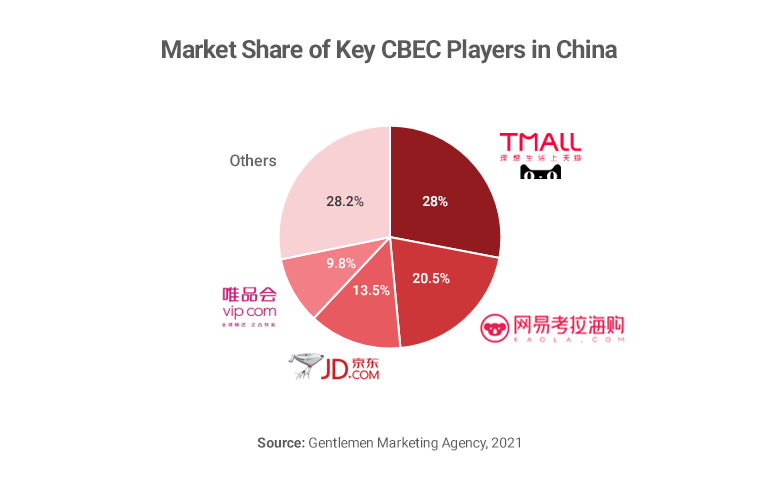
Brief Comparison And When To Use Each Platform
Before diving into selling on Chinese e-commerce platforms, it’s crucial to understand the differences and benefits of each one. Here’s a brief comparison of the major platforms and when it’s best to use them:
| Platform | Advantages | Best for |
|---|---|---|
| Taobao and Tmall | Operated by Alibaba Group, Taobao is the number one e-commerce app in China, with a high gross merchandise volume. Tmall is its B2C counterpart, focusing on branded products. | Brands that want to reach a massive audience and offer a wide range of products, from low to high-end. |
| JD.com | As China’s second-largest e-commerce platform, JD.com is known for its fast delivery and reliable services. | Brands that emphasize product quality and customer service, as well as those in the electronics and home appliance sectors. |
| Pinduoduo | This platform is popular for its group-buying feature and focuses on offering low-priced items, often with discounts. | Brands targeting price-sensitive consumers and want to leverage group-buying and social sharing features for increased exposure. |
| WeChat is the most popular messaging app with more than 1.26 billion users. It offers a huge audience base for all the companies interested in social eCommerce features. | WeChat is the most popular messaging app with more than 1.26 billion users. It offers a huge audience base for all companies interested in social eCommerce features. | |
| Cross-border e-commerce platforms (Kaola, Tmall Global, JD Worldwide) | These platforms simplify the process of entering the Chinese market, providing tools and resources to help foreign businesses sell directly to Chinese consumers. | Foreign brands looking for an easier way to test the market, avoid complicated regulations, and reach Chinese consumers interested in purchasing international products. |
Carefully considering your brand’s positioning and target audience will help you choose the most suitable platform and create a successful e-commerce strategy in China.

Success Stories Of Foreign Brands In The Chinese E-commerce Market
Successful foreign brands in China’s e-commerce market include Nike, Apple, and Uniqlo, who have adapted their products and marketing strategies to appeal to Chinese customers. Here are some examples:
- Nike – The footwear giant understood the Chinese consumer’s love for fitness and launched their Nike Run Club app, which garnered 3 million downloads within a year.
- L’Oreal – The cosmetic brand used an influencer campaign with beauty bloggers to create buzz around their products on social media platforms like Weibo and WeChat, resulting in increased sales.
- Nestle – The Swiss food company developed localized flavors of Kit-Kat bars such as green tea, purple sweet potato, and Sichuan pepper that catered to local tastes, resulting in significant sales growth.
These brands have successfully leveraged Chinese digital platforms and incorporated local flavors and trends into their strategy to increase sales growth in China’s booming e-commerce industry.

What You Should Know About Chinese Consumers
Chinese consumers have unique preferences and shopping habits that differ from Western markets.
Demographics And Psychographics
Demographic segmentation in China includes age, race, religion, gender, family size, ethnicity, income, and education of consumers. When it comes to psychographic profiling of Chinese consumers, it’s important to consider cultural influences and online shopping habits as well as socioeconomic status and purchasing power.
For example, older Tmall users aged above 30 account for a significant proportion (72%) of the platform’s users while male JD.com users make up around 65% of its user base.
Additionally, given that Chinese consumers develop shopping habits early on in life which they then carry through adulthood means that companies should take time to understand these behaviors if they hope to successfully target this audience.
Shopping Habits And Trends
Chinese consumers place great importance on brand loyalty, often sticking with familiar brands throughout their lifetime. New retail is another trend that has emerged in China in recent years. This concept melds online and offline shopping experiences, creating a seamless journey for consumers.
It allows customers to discover products through multiple channels while providing valuable data insights for merchants. Additionally, Chinese consumers have shown an increased preference for personalized experiences, such as customized packaging or targeted promotions based on previous purchases.
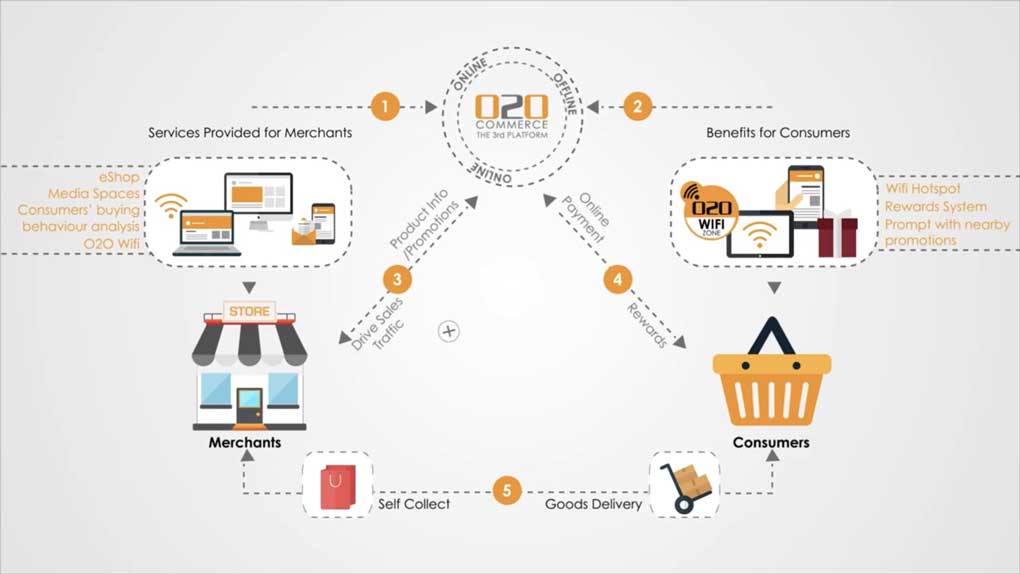
Consumer Expectations And Preferences
Chinese customers are unique in that they demand high-quality products and reliable information about them. They value trustworthiness and transparency from companies, especially given the rise of counterfeit goods in China’s retail industry.
Another important aspect to consider is the role of technology in the buying process. Chinese consumers tend to be tech-savvy and often rely on e-commerce platforms like Taobao or JD.com for their purchases.
Understanding China’s cultural nuances can help businesses tailor marketing strategies more effectively. For example, choosing an auspicious number or color for branding might resonate better with Chinese consumers because of traditional beliefs surrounding luck and fortune.

Strategies For Success In Chinese E-commerce
To succeed in the highly competitive Chinese e-commerce market, it’s crucial to adopt a mobile-first approach and leverage social commerce, understand and participate in Chinese shopping festivals like Singles’ Day, collaborate with KOLs for influencer marketing, and build a strong community through user-generated content.
Localization For The Chinese Market
Localization for the Chinese market goes beyond simply translating content. To be successful, you must conduct in-depth research on the target market and adapt your digital presence and marketing strategy accordingly.
This includes understanding local consumer preferences, cultural nuances, and language use. For example, localization may require changing product names or descriptions to resonate better with Chinese consumers.
Achieving this level of localization requires understanding what makes your brand unique while still appealing to the local consumer base. Take Starbucks as an example; they have successfully localized their menu offerings based on popular flavors and ingredients within China like Red Bean Frappuccino or Oolong Tea Latte.

Mobile-First Approach And Social Commerce
As the number of mobile users in China continues to grow, a mobile-first approach can give your e-commerce business an edge. This means designing for smaller screens and optimizing checkout processes to reduce friction.
Social commerce is important too, as Chinese consumers love to share their shopping experiences with others. Leverage social media platforms like WeChat and Little Red Book for promotions and community building.
Live streaming, or “live commerce,” is also gaining popularity in China – it’s a way to provide real-time product demonstrations while engaging directly with potential customers.
Understanding And Leveraging Chinese Festivals And Shopping Holidays
From Singles Day (November 11th) to the Mid-Autumn Festival, these shopping events offer great opportunities for foreign businesses to boost sales and brand recognition in the market.
For instance, Alibaba broke sales records on Singles Day with $38 billion worth of goods sold across its platforms.
To capitalize on these events, retailers need to tailor their digital strategies to China’s shifting consumer preferences. For example, during Singles Day, brands compete fiercely to offer steep discounts that lure shoppers away from their competitors’ sites.
Unique holiday-themed promotions also help attract customers looking for deals while fostering brand loyalty for future purchases.

Influencer Marketing And KOL (Key Opinion Leaders) Collaborations
These strategies involve partnering with social media influencers who have large followings and high engagement rates, using their influence to promote your brand or product.
With China’s highly engaged social media users constantly looking for new content, brands that collaborate with relevant KOLs can increase visibility and reach more potential customers than through traditional advertising alone.
In fact, Social content created by KOLs in China generates 4 times more views and 8 times more engagement on average than official brand accounts.

User-generated Content And Community Building
UGC is content created by your customers that can be shared on social media platforms or your website. It’s beneficial because it helps build trust, increase engagement, drive conversions, and enhance the overall customer experience.
Community building is also crucial for success in Chinese e-commerce. By creating a loyal customer base through online communities like Little Red Book (Xiaohongshu), brands can gain valuable insights into consumer behavior and preferences.
With Xiaohongshu’s recent transformation from just a shopping guide to becoming a community-driven platform, more than 300 million users are now engaging with its interactive content daily making it an important player in the market.
When done right with proactive customer service as offered by Alibaba’s Taobao Live or VIP programs offered by JD.com brands can even cultivate product evangelists who generate word-of-mouth referrals amongst their peers further strengthening their digital ecosystem and thereby generate loyalty amongst consumers leading them towards repeat purchases that ultimately enhances conversion rate.

Logistics And Supply Chain Management
Efficient logistics and supply chain management are crucial for foreign businesses selling in China’s e-commerce market.
Choosing A Reliable Local Distributor
One of the key factors that can make or break your success in the Chinese e-commerce market is choosing a reliable local distributor. With so many options available, it’s important to do proper research to ensure you’re working with a trustworthy partner.
This includes checking their credentials, verifying their reputation through references and online reviews, and asking detailed questions about their processes for inventory management, quality control, and freight forwarding.
A good local distributor will be able to provide valuable insights and help navigate complex regulations related to taxation and international trade.
An example of the impact of choosing the right local distributor can be seen in the case study of Oreo Cookies entering China’s e-commerce market. The company partnered with Shanghai-based importer Baicaowei Trading Co., Ltd., who helped them navigate Chinese business practices while also providing valuable connections in the industry, growing their retail sales, especially eCommerce sales in China.
This led to a successful launch on Alibaba’s Tmall platform and helped position Oreo as one of China’s top-selling biscuit brands today.

Strategies For Efficient Shipping And Returns
Efficient shipping and returns are essential components of successful e-commerce in China. Here are some strategies to consider:
- Choose a reliable logistics partner early on to ensure efficient and timely delivery to customers.
- Balance value – add logistics with profitability to keep costs low while providing excellent customer service.
- Implement a coordinated supply chain management strategy that covers all aspects of the product’s lifecycle from sourcing to delivery and returns.
- Consider collaborating with transportation professionals and other logistics networks to improve the efficiency of your supply chain.
- Optimize procurement processes by working with local suppliers and manufacturers who can provide high-quality goods at competitive prices.
- Develop streamlined delivery processes that take into account local regulations, customs clearance, and taxation requirements.
- Offer flexible return policies that meet the needs of Chinese consumers, including free returns, extended return periods, and easy-to-use return procedures.
Utilizing these strategies for efficient shipping and returns can help you succeed in the highly competitive e-commerce market in China while maintaining customer satisfaction and loyalty.
Popular Payment Methods (Alipay, WeChat Pay)
One of the most important considerations for any business selling in China is how to process payments. In this market, two payment platforms dominate: Alipay and WeChat Pay. Here are some key facts about these popular payment methods:
- Alipay and WeChat Pay are digital wallets that allow users to make purchases online and in stores using their smartphones.
- Alipay was created by Alibaba Group, while WeChat Pay is a function within the WeChat app owned by Tencent Holdings.
- Both platforms have over 1 billion active users in China, making them an essential part of any e-commerce strategy in this market.
- Alipay is more commonly used for online transactions, while WeChat Pay is often preferred for in-store purchases.
- Both platforms offer QR code scanning for easy payments, making it possible to pay even street vendors with your phone.
- One unique feature of the platforms is their link to financial services such as loans and investments, which can be accessed directly from the apps.
- For foreign businesses selling in China, both platforms allow tourists to use foreign credit and debit cards for payments.
Understanding the intricacies of these payment methods is crucial for any business hoping to succeed in China’s e-commerce market. By knowing which platform best suits your business needs, you can provide seamless payment experiences for your Chinese customers.
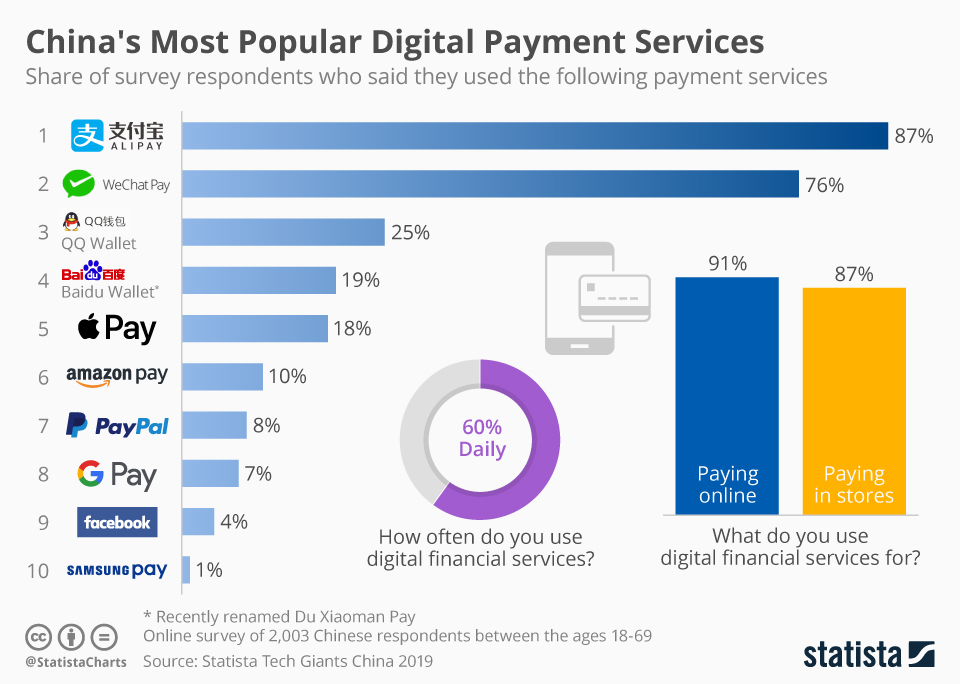
Contact Us To Start Selling in China!
To wrap up, succeeding in China’s e-commerce market requires a deep understanding of the Chinese consumer and localization for the local market.
Key strategies include a mobile-first approach, social commerce, influencer marketing collaborations, user-generated content, and community building.
Efficient logistics and supply chain management are crucial to delivering orders on time and keeping customers satisfied. Online payments through popular providers like Alipay and WeChat Pay need to be integrated into your sales process for easy transactions.

We are a China-based marketing agency focused on digital marketing and e-commerce solutions for foreign brands looking into entering the Chinese market. Over 10 years, our team of Chinese and foreign experts gained the necessary experience and know-how needed for your success in any e-commerce activity in China.
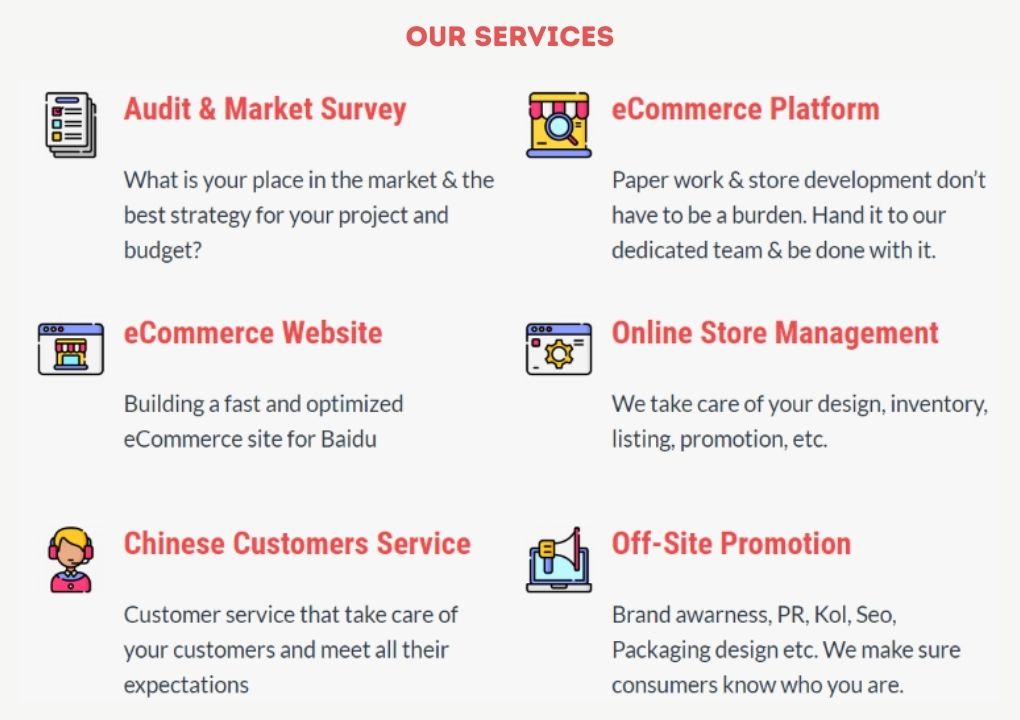
Don’t hesitate to contact us so that we can schedule a free consultation with one of our experts and guide you through the whole process of selecting and entering the e-commerce platform of your choice. Let’s keep in touch!



